Google Photos is an ideal all-in-one solution for storing, editing, viewing, and sharing your photos. To use this service regularly, you need to understand how to upload content. Like Drive, you can upload files to Google Photos in several different ways. Each one of these methods is specifically useful in varying use cases.
In the following article, we will look at different methods for uploading an entire photo library to Google Photos. Some of these procedures are automated, while others require you to pick each file on the go. Once you have uploaded the photos to this online storage, they can be saved as a backup or shared with others through albums and other utilities.
Why upload photo libraries to Google Photos?
One of the most crucial aspects of cloud-based storage is its backup capabilities. Keeping the entire library in a single location makes it prone to data loss or compromise. On the other hand, remote storage such as Google Photos works perfectly fine to keep these pictures entirely safe. It saves your photos and videos and gives quick and easy access whenever you want. You will not find any difference to a locally stored library other than needing an active internet connection to make modifications.
Other benefits include never losing your data, even if the storage gets corrupted with viruses or malware. The files you store on Google Photos are kept safe with high-grade security protocols that cannot be easily breached. Moreover, doing so will also remove a considerable burden from your device’s storage. Any files set to be automatically uploaded to Google Photos will take away little to no space on your hard drive or memory card. Read through our article on installing and using Google Photos on Chromebook.
Besides, in more cases than not, you won’t have to upload these libraries manually. When you set up Google Photos for desktop, all files are synced on their own without any need for individual alterations or separate commands. After the initial transfer, any edits made to that folder are also mirrored in Google Photos. Depending on how a library is presented, you can generate automatic movies, collages, animations, and panoramas. None of these options are available on any local operating system.
Checklist for uploading photo libraries to Google Photos
Before you start uploading these files, make sure to have a speedy internet connection. It becomes increasingly important if your library contains a significant number of files. Also, make sure that all photos present inside the library are within reasonable size limits. Photos that are larger than 150 megapixels cannot be uploaded as quickly. Though such files are relatively uncommon, you will probably never have to deal with such extremes.
Another crucial thing to consider is that all photos in your library conform to the allowed file types. These include .jpg, .png, .webp, .gif, .heic, and RAW images. If any file does not fall into one of these categories, it will be omitted during the upload. Lastly, keep checking that you have enough storage on your Google Photos account. Keep in mind that your account storage is shared across multiple products such as Photos, Drive, and Gmail. You cannot upload new files without purchasing a new package if you have consumed all storage.
Uploading a photo library manually
If the library you want to upload contains fewer photos, a better option would be to upload the library manually. With individual uploads, you get to choose between different types of files, which usually saves considerable effort on your end. However, if the library consists of multiple files, you are better off with an automated alternative discussed in the next section.
Step 1: Launch your preferred internet browser and go to “Google Photos.” Log in with your account.
Step 2: On the “Google Photos” homepage, notice the options in the top right corner next to your profile picture. Click on “Upload.”
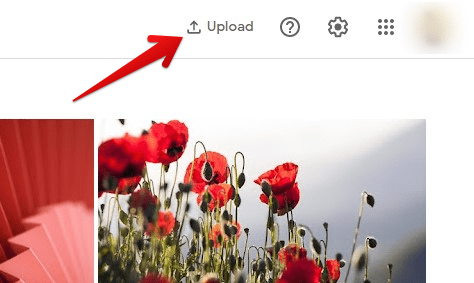
Upload button in Google Photos
Step 3: Select “Upload from Computer” from the drop-down menu. If the respective library is present on Google Drive, skip over to the next section in this article.
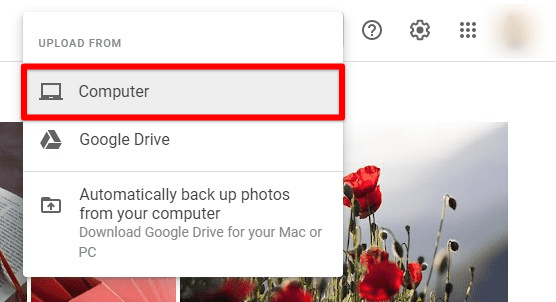
Uploading a library from a computer
Step 4: A pop-up window will open on your screen. Browse to the library folder and select all files to be uploaded. Click on “Open.”
Google Photos will include the entire library in an uploading queue. You can check the process progress from a tab in the bottom left corner.
Step 5: Once the upload is completed, you can relocate the photo library to any other folder inside Google Photos. It can also be renamed or set as an album.
Here is a guide on creating and sharing albums in Google Photos. Depending upon the total size of your photo library, it may take anywhere between a few minutes to several hours for the entire process to finish. If your device loses the connection midway, the upload progress is saved accordingly. It then resumes whenever the internet becomes available next time.
Uploading a photo library via Google Drive for desktop
Uploading it through Google Drive for desktop seems reasonable for those with a photo library with thousands of files. The setup for Google Drive, when installed, enables you to mirror any file on your system with your online storage. Since the drive is shared with Photos, you do not have to install separate software for Google Photos. Google Drive for desktops contains inherent filters that can send all media files directly to their respective service.
Step 1: Launch your preferred internet browser and go to this link. Download Google Drive for desktop. This setup is compatible with all versions of Windows 7 and onwards.
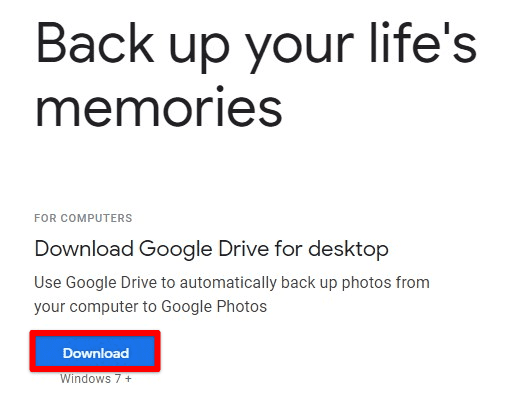
Downloading Google Drive for desktop
Step 2: Run the .exe file as an administrator and allow it to make changes to your device. A Google Drive icon will appear in the Windows taskbar when the installation finishes.
Google Drive icon in Windows taskbar
Step 3: A small window will pop up next to the icon. Click on the gear icon in the top right corner and go to “Preferences” from the drop-down menu.

Opening Google Drive preferences
Step 4: Doing so will open the “Google Drive Preferences” window. Make sure that you are on the “My Laptop” tab. Click on the “Add folder” button.
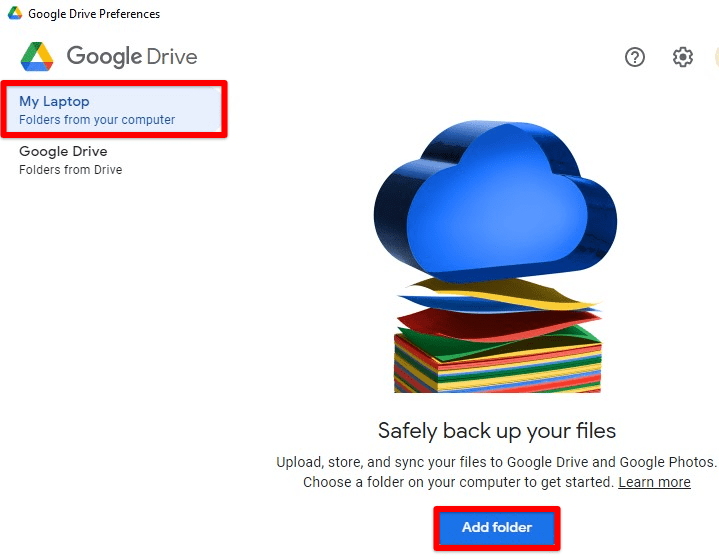
Adding a folder from your computer
Step 5: Go to your photo library folder, select it, and click on “Select folder.”
All files within that folder will start syncing with Google Drive and Google Photos. If the folder only contains pictures and images, these contents are uploaded to Google Photos on their own.
Uploading a photo library through other cloud storage
It is possible that the library you want to upload already exists in another cloud storage. You will have to link that drive with Google Photos so that the contents can be transferred in a single step. A third-party application can be used for such purposes. One of the most reliable and secure platforms for doing so is MultCloud. It lets you integrate multiple cloud storage accounts under the same service. With these accounts linked, you can transfer files between any two of them.
What’s great is that MultCloud has no local storage involved, as it can upload the photo library directly from one cloud to another. It can be automated to a degree where transfer patterns are stored and activated whenever a new media file is uploaded to that library. It keeps both storages perfectly synced with each other.
Step 1: Go to this link and click “Sign Up for Free.” On the sign-up page, fill in the details for your account.
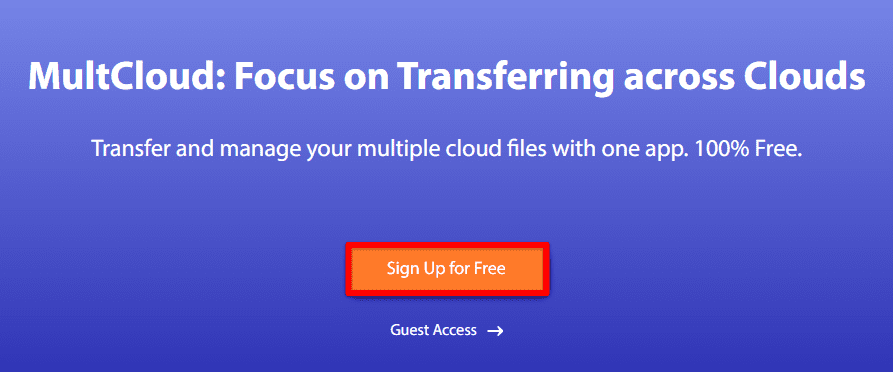
Signing up for MultCloud
Note: You need to have a valid email address for creating an account on MultCloud. It may also be signed in with Facebook or Google. Besides, you can also check out their service as a guest without linking any account.
Step 2: After you sign in, go to the “Add Cloud” tab located in the left pane. Here, you will see a list of cloud storage services.

Add cloud tab
Step 3: Add “Google Photos” and the other cloud from which the library will be uploaded.
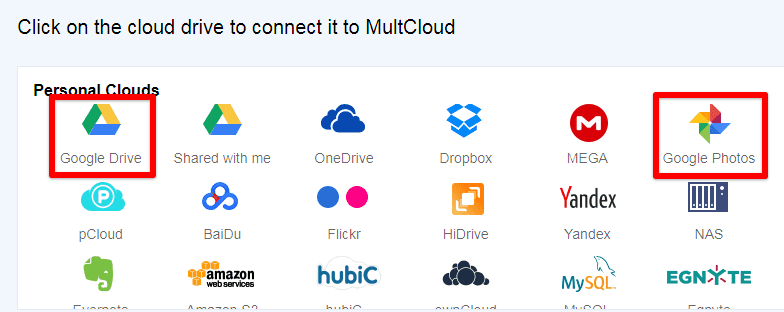
Adding cloud accounts
Step 4: Once both accounts have been added successfully, click on the “Cloud Transfer” tab under “Common Tools.”
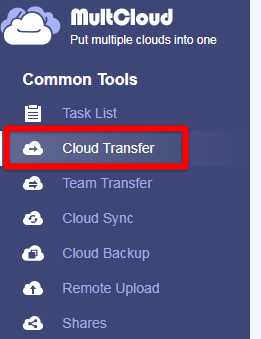
Cloud transfer under common tools
Step 5: MultCloud will now ask you to select a source and destination. Select “Google Photos” as the destination and the other storage as the source. Next, click on the “Transfer Now” button in the bottom right corner.
After the transfer finishes, all photos in your online photo library will be present in Google Photos. Since the transfer takes place entirely over the internet, the time it takes to complete may vary. For that reason, rather than transferring the files right then, you may want to schedule it after working hours. There are tons of optional add-ons available, such as filters for photo libraries. You also choose to delete the photos and videos from the source account afterward.
Conclusion
Google Photos offers an alternative approach for storing and managing your photo libraries. It hosts all tools required for you to make necessary adjustments and edits. There are three common methods to upload an entire photo library to Google Photos. You can either upload the library manually, sync it through Google Drive for desktop, or employ a cloud transfer service. Do you have to edit photos regularly? Browse through the list of the 10 best photo editors for Chromebooks.
